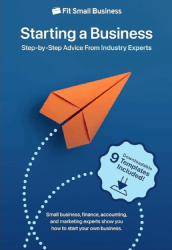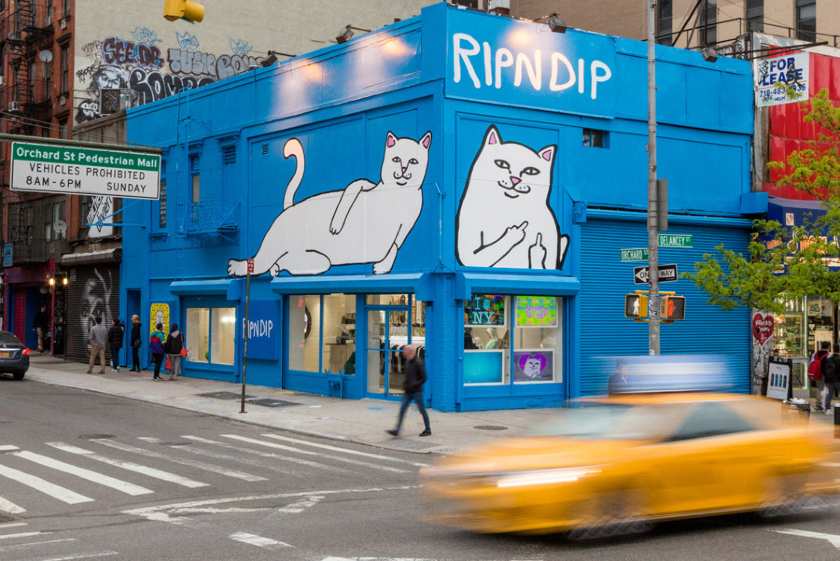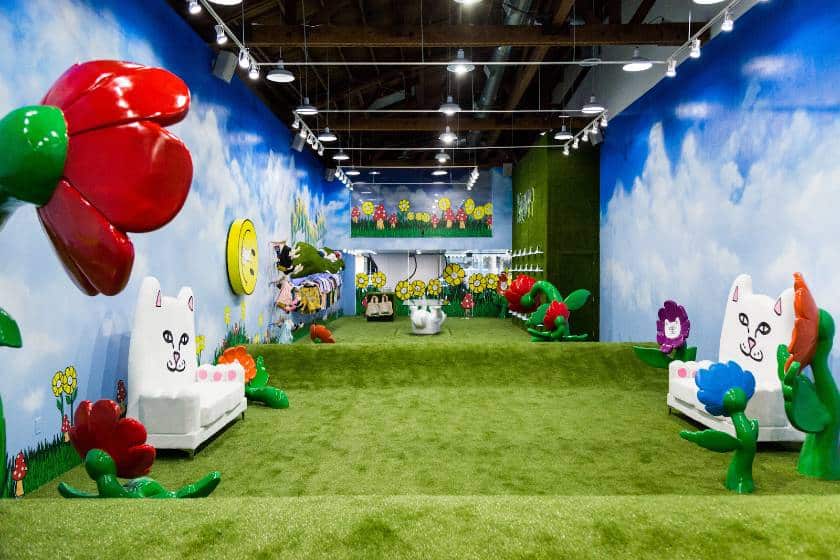Pop-up shops are temporary in-person retail activations that allow you to open a small store for a limited amount of time, enabling customers to interact with your brand and products in person.
Pop-ups are also a fun way to build hype around your products, reach new customers, test product lines, and offer exclusive services or items. The pop-up shop market is growing and is currently worth about $15.6 billion1. So, there’s plenty of opportunity.
Here’s how to start a pop-up shop in 10 steps:
Step 1: Determine the Goal of Your Pop-up Shop
If you want to open a pop-up shop for your business, you’ll want to start by choosing your goal. Without a target in mind, it will be difficult to plan, execute, and assess your pop-up shop.
Why Open a Pop-up Shop?
There are many reasons why small business retailers may open a pop-up shop, including:
Pop-up shops offer an avenue to build in-person connections that online shopping can’t replicate. Consider looking at retail metrics like repeat purchases, email signups, and other indications that customers feel a stronger connection to your brand post-pop-up.
During the holiday season, luxury brand Cuyana decided to open a pop-up shop to allow for in-person shopping. This alleviates stress and the question of whether an order will arrive in time for the holidays.
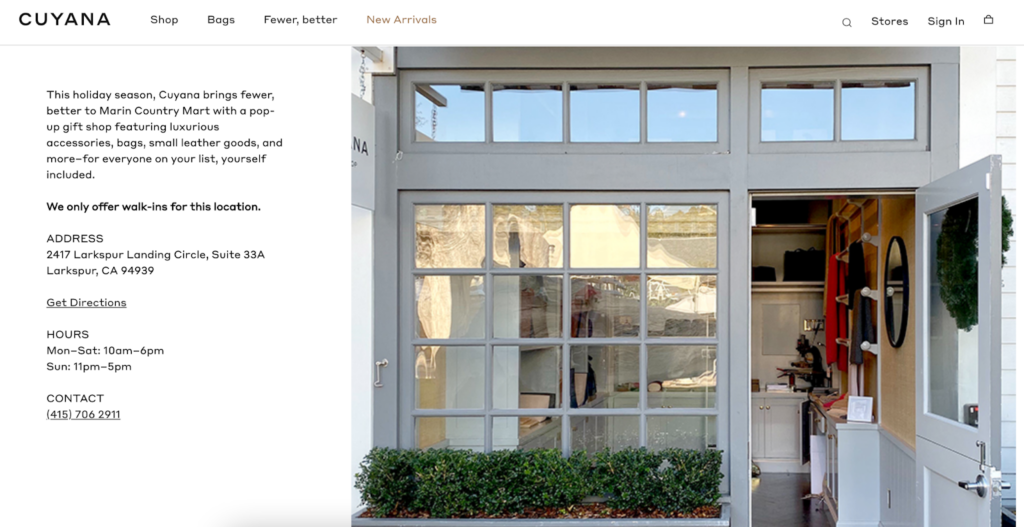
Pop-ups can build customer trust for ecommerce businesses.
Pop-up shops are a great way to increase retail sales because they give your customers a reason to buy new products. Maybe seeing your items in person gives the boost they need to finally convert, or it could be the temporary nature of the store that fosters a sense of urgency.
Apparel brand Plant Man P had a pop-up shop with plan store The Sill, releasing a special in-store-only T-shirt design made in collaboration with the plant retailer. It also forced shoppers to visit The Sill store. The goal was to create more of an immersive experience.
Shipping costs are a necessary evil when it comes to ecommerce. Though it’s best to offer free shipping—especially considering two-thirds expect it—this isn’t always possible. With a pop-up shop, you can turn your space into a fulfillment center, allowing online customers to pick up their orders in person.
The click and collect—or buy online, pick up in-store (BOPIS)—fulfillment method was trending pre-COVID and has skyrocketed since. In fact, half of shoppers continued to use this option even after pandemic restrictions were lifted. It also offers an opportunity to upsell and cross-sell.
Pop-up shops offer an affordable way to test the retail market before fully investing in opening a retail store. It can cost up to $100,000 to open a permanent shop—you can execute a temporary pop-up for a fraction of the cost. In fact, pop-up shops are an excellent way to make sure starting a retail business is right for you because it’s a relatively low-commitment foray into retail.
This is exactly the approach Warby Parker took before the once online-only brand expanded into physical retail. Now they have locations across the country and even a few in Canada.
Pop-up shops can help you build buzz and awareness for your brand and products. This is especially useful if you’re a newer business or targeting a new audience segment. You can also collaborate with other brands on a pop-up shop to put your business in front of their audience—and vice versa. Some permanent retail stores also host pop-up shops within their spaces, another excellent way to put yourself in front of a new but targeted audience.

Viera Swim and Amy Hicks Photography collaborated on a pop-up shop together, hosted at restaurant Ces’t La Vie. (Source: Ces’t La Vie)
Because pop-up shops are in-person, they offer different opportunities to provide complementary services to your customers. Today’s shoppers want more than just to make a purchase and leave—they want an experience. If you sell clothing and accessories, perhaps offer free hemming at your pop-up. If you sell skincare products, you might provide free facials or massages.
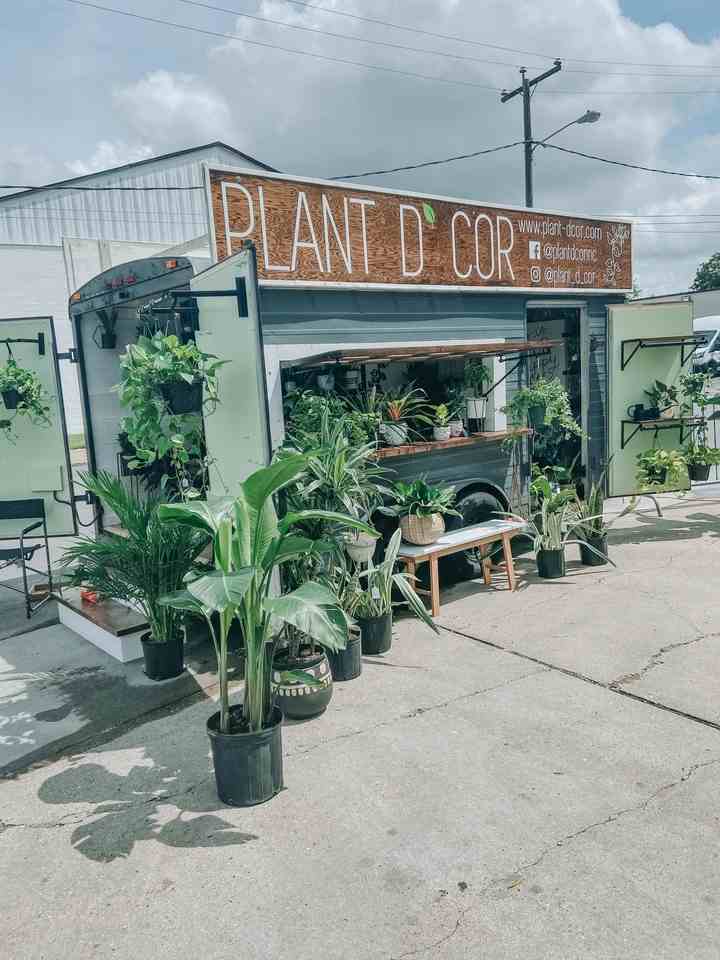
Plant D’Cor used its pop-up shop to diagnose plants and give plant care advice to get them back to their best. (Source: Plant D’Cor)
Step 2: Know What Kind of Pop-up You Want to Have
Pop-up shops have evolved since they first hit the retail scene. While the “traditional” approach might involve a temporary store or tent in a high-traffic area, today starting a pop-up can take a variety of forms and methods:
- Markets and fairs: Typically made up of a collection of vendors with smaller tents or tables—you’ll need lots of space and separate areas
- Pop-in shop: When a brand has a pop-up shop within another store (or restaurant) location; fashion brand Kūla frequently does this at The Trove and other local shops
- Launch party: To introduce your brand or debut a new product or collection
- Immersive experiences: Less shopping-oriented and more about creating an impactful interaction with shoppers; perhaps services, workshops, product demos, and other interactive elements are involved
- Press previews: Invite-only events to debut new products and happenings to the media to build awareness and buzz
- Influencer pop-ups: Also meant to build buzz, these events are typically tailored to influencers and creators
- Mobile: Some pop-ups are on wheels—like the Hello Kitty Cafe Truck
September is going to be super sweet! The #HelloKittyCafe Truck is coming to a city near you 💖 📢 Find out where the truck will be stopping by here: https://t.co/frQGIcffnL
Thank you for the sweet photo _yadi10__ on IG💕 pic.twitter.com/u5SFXprPEN— Hello Kitty Cafe (@HelloKittyCafe) September 1, 2022
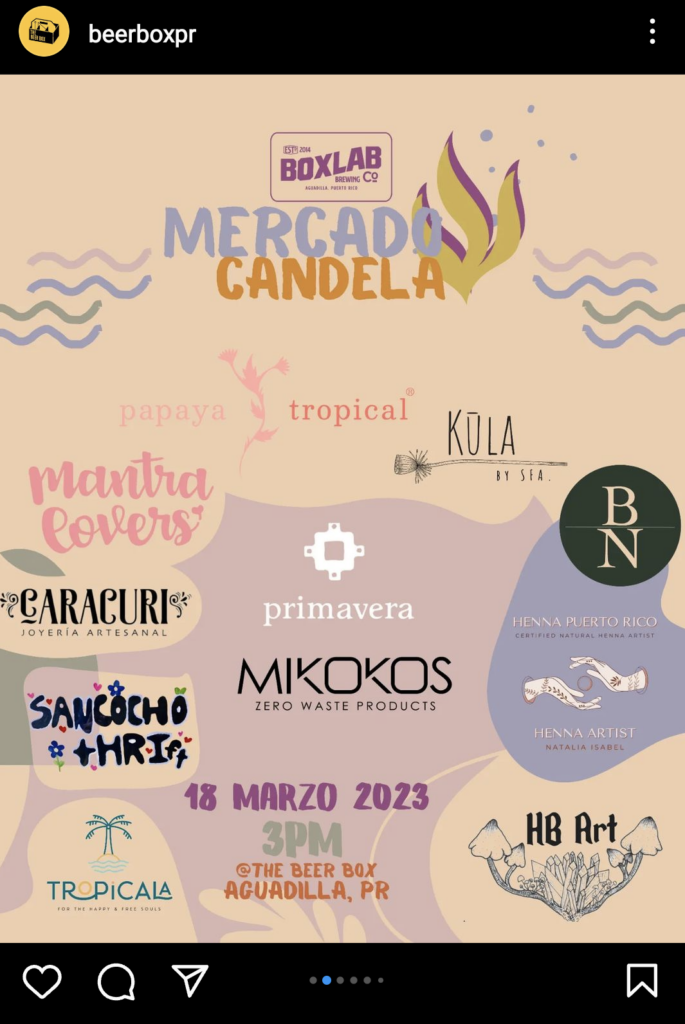
Partnering with other local businesses is a great way to expand your customer base and brand awareness. Partnering with other businesses for a pop-up also lessens the burden of marketing costs, as you can all pitch in.
Step 3: Set a Budget
Before you start scouting locations, consider your budget.
Your budget will depend on several factors, including location, length of lease, and size of your pop-up. When determining your ideal rent, it’s wise to research the rent prices in the area to have a good idea of what to expect. A quick search on PopShop.com shows venues in New York City go for anywhere as low as $100 per day to more than $2,000 daily.
Rent isn’t the only cost you’ll incur with a pop-up store. You also need to factor in staffing, marketing, inventory, space modifications, insurance, and technology expenses. When negotiating your rental agreement with the landlord or real estate agent, remember to ask what’s included—and it can’t hurt to try to negotiate extra or reduced expenses for things like WiFi, utilities, and licensing.
Step 4: Choose a Location for Your Pop-up Shop
Scouting the perfect location for your pop-up store is key to your success. But before you hit the pavement, you need to identify your must-haves to help narrow down the search.
When thinking about where you want your pop-up to be, consider where your audience is most likely to be. If you already have a successful online business, look at your existing customer demographic data to see where most shoppers are located.
Once you know roughly where you want to have your pop-up shop, narrow it down and consider the following attributes of your location:
- Type of space: Pop-ups can happen in a variety of areas, including vacant storefronts, galleries, pop-ins with existing stores, shopping centers, malls, or even mobile stores with trucks or buses. If you want to know how to do a pop-up shop outside, for example, look for locations that offer shelter from sun, rain, and other weather-related elements.
- Your target market: Choose a neighborhood or area your preferred customers will frequent. You’ll also want to consider if you want to be in a city or a more rural area.
- Branding and business goals: Find a location that makes sense for your brand and the future vision you have for your business. For example, if you want to test the idea of opening a permanent storefront, choose to host your pop-up in a location you’d also consider for that permanent fixture.
- Events or areas of interest: Research local events and tourist attractions in the area that would drive additional foot traffic—or make your event a hassle.
- Accessibility: Figure out how customers are going to find your location and get to it (by personal or public transportation). Consider local bus stops or train stations as well as parking options. Try to find an area with plenty of parking or access to public transportation.
Narrowing Down Your Venue
Once you’re ready to select a venue, think through the following:
- Store layout: Visualize what the space will look like with your pop-up. You’ll need to think about your ability to not only display products for customers but also stock extra inventory out of sight.
- Venue amenities: Know precisely what comes with the space to avoid unwanted surprises. Check with the landlord about reliable WiFi, electrical outlets, lighting, security cameras and alarms, and restrooms. If a utility like internet access isn’t provided, consider a mobile hotspot and make sure it works reliably in the space.
- Rent: Determine the rate and the time frame you will operate your store and understand the included extras such as parking. Remember to include any costs for the required insurance.
- Modifications to the space: Making the store fit your vision could require physical changes. Make sure you and the landlord agree on what is and is not acceptable.
Plus, because a pop-up shop is temporary, you’ll want to pay extra attention to your pop-up shop setup and teardown. Determine whether your potential venues offer an easy way to set up a pop-up shop and take it down when it’s over.
Step 5: Obtain Licenses & Permits
Perhaps the most tedious part of learning how to open a pop-up shop is navigating the laws and regulations. Your required licenses and permits depend on many different factors, including location and what types of activities you plan to have at the pop-up shop. At a bare minimum, you’ll want to have the following:
- Business license
- Business registration
- State sales tax permit
Other potential licenses and permits may include:
- Building permit for major changes to the physical space
- Noise permit, essential if you plan to have live or loud music
- Liquor license if you plan to serve and/or sell alcohol; this is estimated to be around $300
- Racking permit if you have storage exceeding 5’9” in height
- Sign permit for your storefront sign
- Food Handler and safety permits if you plan to serve and/or sell food
It’s always best to check with your local jurisdiction to see what’s required of you. The city of Chicago, for example, issues specific pop-up shop permits. A five-day Tier I license costs $25, or you can invest $150 for a year-long license.
Step 6: Prepare Inventory for Your Pop-up Shop
Setting up a pop-up shop also requires inventory. When prepping inventory for your pop-up shop, you’ll need to consider the following inventory management challenges:
- Transporting inventory: How are you going to get the products to your pop-up shop? How are you going to pack up the unsold products after your pop-up shop, and where will you take them?
- Storing inventory: Do you have space at your pop-up shop to store extra product or will you need to keep it somewhere else? What else do you need to properly store stock—security, temperature control, ladder?
- Replenishing inventory: When you sell out of product at your pop-up shop, how will you restock the shelves? What will you do if you run out of inventory altogether before your pop-up is complete?
- Tracking inventory: Is your technology able to sync inventory data with other sales channels?
Step 7: Set Up Your Pop-up Shop Software
The exact technology you need will depend on the type of event you’re hosting. At a minimum, you’ll need a way to accept payments, probably with a card reader and connected point-of-sale (POS) system. If you already have an online store, see what solutions that company offers for in-person selling, as that will likely be your easiest option.
For example, if you have a Shopify store, you can get a free POS app and either accept payments through your smartphone or rent or purchase a chip-and-tap card reader.
Altogether, you may need:
- Point of sale and payment processing: The right POS system can act as a total business command center, a place where you can not only administer transactions but also view inventory, customer, sales, and other relevant data.
- Barcode scanners: Barcode scanners will help you speed up the checkout process and capture accurate sales data. Adding a barcode for each product saves valuable time at checkout, which is especially essential at pop-ups.
- Reservation or appointment systems: Appointment-based shopping can help with crowd control, ensure accurate staffing, and build demand before your event.
- Ticketing software: If your pop-up shop is exclusive to an RSVPed guest list, you’ll want to set yourself up with some form of ticketing software to streamline the process and collect additional data points to build on those customer relationships well after the pop-up.
Find a solution for your pop-up:
Step 8: Get Your Team Ready
There are two main ways you can staff your pop-up shop: hire new employees or use the ones you already have. If you’re hiring temporary staff to work the shop, your approach can be similar to if you were hiring seasonal staff. Write a well-developed job description and ad, start recruiting early, and get out there to promote your openings.
Onboarding temporary pop-up staff and training your existing staff for the pop-up shop should be similar. The former will need extra brand and product training, while the latter will need more pop-up-specific training and development. Both groups will need training on your tools, including the POS, customer relationship management (CRM) software, inventory management software, barcode scanners, and more.
Step 9: Promote Your Pop-up Shop
It’s helpful to divide your retail marketing strategy for your pop-up shop into three key phases: before, during, and after.
Before
Before your pop-up shop launches, your job is to build buzz and get people excited about the upcoming event—excited enough to mark it on their calendars and even share it with their networks.
Some marketing channels to consider pre-pop-up include:
- Email: Email marketing is a powerful tool because it’s a direct line of communication to your customers. Amp up your pop-up event with an email blast or even a series of emails to send to your list beforehand.
- Social media: There are more than 4.3 billion people on social media worldwide, so you’ll want to craft a social media strategy to reach those potential buyers. Create a Facebook event to hype up the event—and so people are notified when it’s here. You can also create a countdown on Instagram and tell your Instagram followers to turn on post and story notifications.
- Event websites: Facebook events and sites like Eventbrite or Yelp are excellent channels to promote your pop-up shop. For example, Not Enough Studios created an Eventbrite event to promote its ongoing Makers Market pop-up shops.

Creating event pages for your pop-up on Facebook and Eventbrite is an easy way to boost visibility.
- Paid social: Social media is also a great channel for paid advertising. Investing in social ads allows you to target your audience more specifically. For pop-up shops, you’ll want to focus on people who fit your target market and are located in the nearby vicinity.
- Paid ads: Again, paid display and search ads allow you to target specific audiences with tailored messaging about your upcoming pop-up shop.
- Your website: Any information about upcoming pop-up events should be easy to find on your website. Promote it on your homepage banner and consider making a page dedicated to events and news.
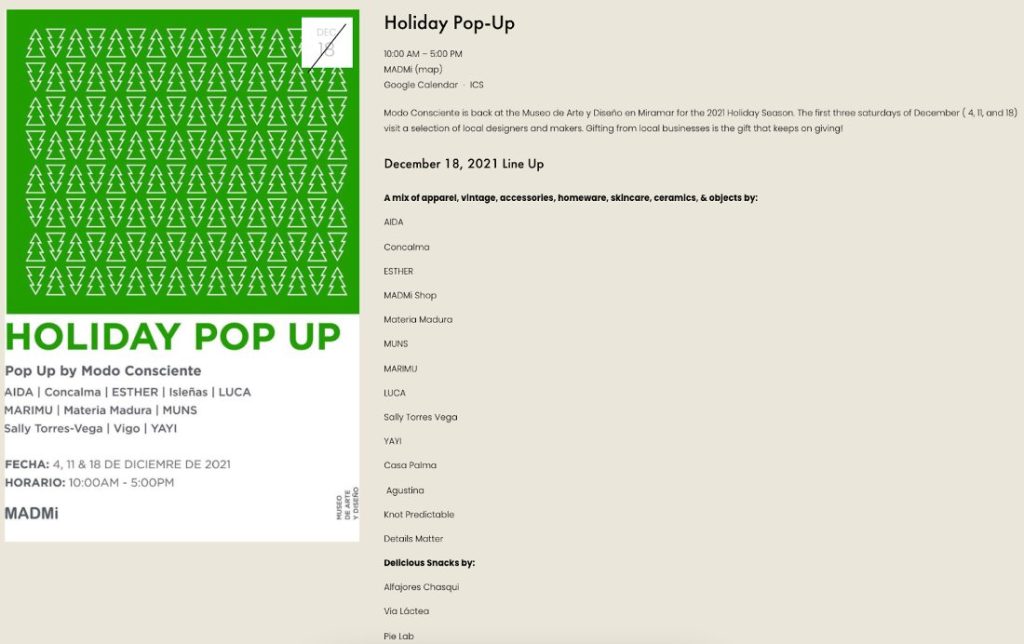
Modo Consciente has its own events page where it shares details for pop-up shops. (Source: Mondo Consciente)
During
Your marketing efforts aren’t over once the pop-up has begun. In fact, far from it. During the pop-up shop, you can continue to build buzz and reach new audiences—and even lure them in to make a purchase.
- Livestream: You can broadcast your pop-up shop live to your digital audience. Live streaming is an excellent way to create a way for people to interact with the pop-up shop even if they can’t physically be there. Plus, many social platforms alert page followers when they go live, so this can serve as a reminder for local followers to visit the event.
- Hashtags: Incorporate local and industry-relevant hashtags into your social posts and live streams. Consider creating your own branded hashtag associated with the event and encourage shoppers to tag their posts with it.
- Proximity marketing: You can run ads that hyper-target your local market and encourage them to visit your pop-up shop while they can.
- Build your email list: Collect shoppers’ email addresses at the point of purchase and add them to your email subscription list. This will allow you to nurture the relationship over time as well as promote future pop-up shops. Remember to use an email platform that will allow you to tag or segment these customers as people who have visited a pop-up shop in the past.
After
Your efforts are still needed even after the pop-up shop has finished. Marketing your pop-up shop, brand, and products should never stop—and there are many ways you can leverage the pop-up for post-event marketing.
- Say thanks: It’s important to recognize and thank the people who came to and supported your pop-up shop. Ideally, you collected email addresses or even phone numbers from shoppers during the event. Afterward, you can communicate with them to share your gratitude for their attendance. Go the extra mile and offer a discount or some sort of free gift to show your appreciation.
- Future events: If you plan to host future pop-ups and events, don’t forget to invite your attendees. Chicago’s Christkindlmarket market is a German Christmas Market that happens every year. Rather than taking its website down after the holidays pass, it maintains a simple site and updates it for the following year, showing people they have another pop-up to look forward to.

When your pop-up is over, maintain momentum by promoting your next event.
- Recap: Share a recap or highlight reel from the event with your audience. You can post this on social media, send it out via email (remember to include pop-up attendees!), and share it on your website. You can also repurpose and use this content to promote future pop-up shops.
Jewelry brand Caracuri shared a highlight reel of one of its previous pop-ups, eliciting FOMO-like feelings from shoppers who didn’t attend.
Step 10: Post-mortem—Measure the Success of Your Pop-up Shop
When your pop-up shop has completed, it’s important to conduct a post-mortem analysis to find out what worked, what didn’t, and why. You can then apply these learnings to other areas of your business, as well as keep them in mind for future pop-up shops.
When measuring the success of your pop-up shop, consider the following retail analytics key performance indicators (KPIs):
- Foot traffic: You’ll want to count how many people walked into your pop-up shop. While you can technically do this manually, there are many foot traffic counters and technologies you can use to streamline the process and improve the quality of your data.
- Sales: It’s always a good idea to consider your total sales for any campaign or event. This will tell you how many items you sold and how much revenue you generated for those sales.
- Conversion rate: Your conversion rate tells you the percentage of people who visit your pop-up and end up making a purchase.
- Average transaction value (ATV): This metric tells you how much a customer typically spends in each transaction. You can compare your pop-up’s ATV to your ecommerce ATV and the ATV for other types of transactions to see which channel drives the highest ATV.
- Sales per product: Breaking sales data down by product will reveal which items shoppers are most interested in. Consider these metrics when forecasting sales and your buying strategy.
- Sales by day/time/hour: It’s helpful to understand when your pop-up generated the most sales. This information will inform future pop-up hours and potential brick-and-mortar store operating hours, as well as staffing decisions.
- Sales by customer: Find out who your top spenders are and see what they buy. Look for trends and then find ways to tap into other customers with similar spending habits. Use this data to create shopper profiles so you can personalize marketing in the future. Pay extra attention to the customers’ ZIP codes.
- Social mentions: Your pop-up shop isn’t just about driving sales. You also want to build your digital audiences and boost engagement. Track social mentions and the sentiment of what people are saying about your brand and pop-up online.
- Email subscribers: Building your email list should be a secondary goal to every pop-up shop. Consider how much your list grew as a result of the pop-up shop.
Frequently Asked Questions (FAQs)
You can spend as much or as little as you want to open a pop-up shop. A small event at an already established location could set you back less than $1,000, whereas a monthlong pop-up shop or mobile pop-up tour might cost more than $100,000. It all depends on your budget and needs.
Yes, pop-up shops make money if you promote them successfully and offer ways for shoppers to make a purchase while attending the pop-up.
Pop-up shops are worth it if you plan strategically and execute with a vision and goals in mind.
- A lot of work for a temporary activation
- People might miss out on the event
- Requires a lot of promotion and awareness-building
- Could cost a lot of money
- Can take away focus from other parts of the business
- New logistical challenges
Bottom Line
Learning how to start a pop-up shop is a great way for brick-and-mortar and ecommerce merchants alike to build buzz about their brand and products. Temporary retail activations give shoppers a reason to get excited about your brand, and it’s an ideal way to test physical retail without making the full investment in a proper storefront.
Reference:
1 IBISWorld
